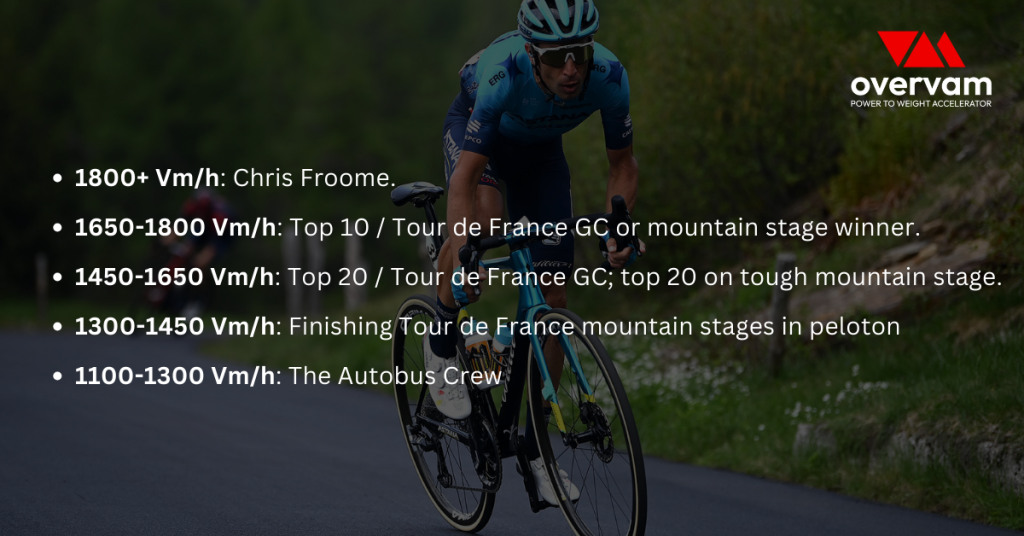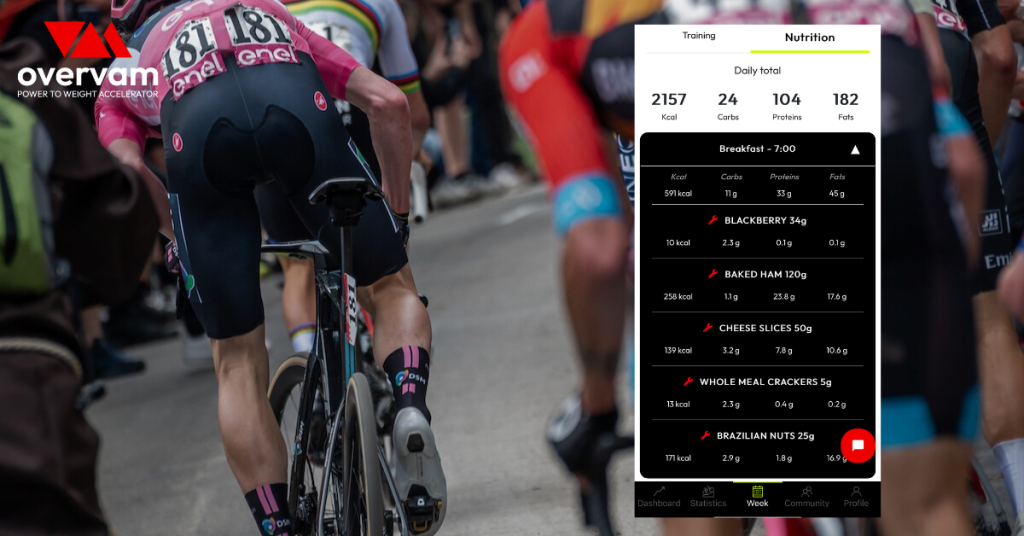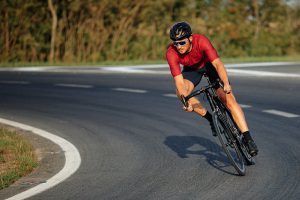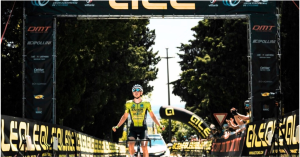VAM: A BRIEF DESCRIPTION
What is VAM in cycling?
VAM in cycling stands for “Velocita’ Ascensionale Media“; it’s a field performance index invented by Dr. Michele Ferrari in the late ’90. It is valuable for comparing the performance uphill of different cyclists with different body weights and power.
The formula of VAM in cycling = (metres ascended × 60) / minutes it took to climb (Strava Support. Retrieved 2020-08-07). It is expressed in meters per hour (m/h). Click here to calculate your VAM
VAM in cycling directly correlates with a cyclist’s relative power (power to weight ratio or W/Kg) and climbing time; (see below graph; a cyclist of 70kg body weight with different power to weight ratio, on a climb with 8% slope, was used in the example).
How can you improve VAM in cycling?
It’s necessary to optimize body weight or improve power to improve VAM, possibly both. This article will review scientific methods to increase power while decreasing body mass (Kg). In this article, you will learn how to use and improve it, becoming a faster cyclist.

VAM: CLIMBING TIME!
Which VAM have the best cyclists? Put into another perspective, which VAM is necessary to win a stage of a Big Tour or even its final general ranking?(1)(2)(3)(4)
The contendents for the final victory should target a VAM of 1800m/h+, beneath riders who recently achieved this VAM, Chris Froome.
With a VAM between 1650-1800m/h, a pro rider may target the victory of a mountain stage or the top 10 in the general ranking at the end of a Grand Tour. The VAM of 1450-1650m/h allows a pro rider to rank in the top 20 in the final ranking of a Grand Tour.
A VAM of 1300-1450m/h is the “gruppetto”, the small peloton with the sprinters. A VAM of 1100-1300m/h is the “Autobus Crew”, which means comprehending all those cyclists who, in a Grand Tour, are not likely to rank.
WHICH VAM IS NECESSARY TO WIN A GRANFONDO?
A VAM OF 1450-1650 m/h is also necessary for an amateur (or age-grouper cyclist) to win a mountain granfondo with long climbs and significant positive gain.
The table below shows what is the significance of VAM in cycling!

HOW TO IMPROVE VAM
VAM in cycling may improve by following some simple strategies, explained below.
VAM IN CYCLING: THE ANAEROBIC THRESHOLD
One component of VAM in cycling is power!
It usually refers to power at an anaerobic threshold. The anaerobic threshold usually refers to the exercise intensity that causes an arterial lactate level of 4 mM/L, known as the onset of blood lactate accumulation (OBLA)(5). Cycling power optimization requires increased power output while keeping blood lactate levels lower.
A recent study (Rønnestad et al., 2013)(6) shows how including short high-intensity intervals (SI) in workouts promotes higher results when compared to long intervals (LI). The primary finding in the study is that performing HIT as SIs induced superior training adaptations on several endurance and performance measurements, compared with performing HIT as LIs, despite similar effort and work time during the HIT sessions. SI cyclists had a more significant relative increase in VO2max, Wmax, and mean power output during the 30-s Wingate test and tended to show more
substantial increases in power output at 4 mmol/L [La–] and mean power output during the 40-min all-out trial compared with LI cyclists. Periodization is also a crucial factor in increasing the anaerobic threshold!
VAM IN CYCLING: WEIGHT MANAGEMENT FOR CYCLISTS
According to Newton’s law of motion on an inclined plane, movement is directly influenced by the total weight of an object (in this situation, cyclist + bike). This law suggests that optimal body weight is essential to increase VAM in cycling!
Although it is well established that a caloric restriction is necessary to obtain a loss of body mass, independently of the adopted nutritional style, recent pieces of evidence suggest that Time-restricted eating (TRE) (7)(8), a popular dietary strategy that emphasizes the timing of meals in alignment with diurnal circadian rhythms, permitting ad libitum energy intake during a restricted (∼8–10 h) eating window each day, allowing for higher metabolic health and possibly a better lipid metabolism during nocturnal hour with a greater fat loss. (7)(8), allowing an increase in the power-to-weight ratio and a higher VAM in cycling.
VAM IN CYCLING: KEY POINTS FOR IMPROVING CLIMBING TIMES
Here are two simple strategies to improve VAM in cycling.
- Applying a small energy cut (energy cut = energy expenditure – energy intake). A cut of ∼250 kcal/day may lead to a -1 kg BW loss in a month. Remember that smaller caloric restrictions correlate with lower lean mass loss.
- Restricting the time of the energy intake to 10 hours/day may lead to higher metabolic health and fat loss during nocturnal hours.

VAM: CONCLUSIONS
Although VAM in cycling is not directly trainable (being the sum of several factors, i.e. Power (Watt), Weight Management (Kg) and genetic factors such as height (cm) and frontal area (m2)), it’s still a valid performance index to quickly compare the performance of different cyclists with different body weights and power at anaerobic threshold.
VAM in cycling also allows targeting a specific ratio (power divided by body weight) to rank at a cyclist’s own best in particular races, specifically mountain events, or trying to get faster and grab a new PR or a KOM on the “dream climb.” taking his own crown!
Do you clearly understand what VAM is in cycling and how you can improve it?
OVERVAM is the most complete app integrating training and nutrition, allowing you to increase your VAM and become a faster cyclist! Available on the App Store, Google Play and OVERVAM Web.

Gherardo Marcolin, BSc, IOC Diploma in Sports Nutrition, Swiss Triathlon coach, Swiss Sports Nutrition Society, MBA, Cyclist and Triathlete.
REFERENCES
- Tim M., An interview with Dr. Michele Ferrari
- Michele F.: The rider’s performance, how to measure it
- Gregor B.: Efimkin does 1600 m/h
- Gregor B.: Simoni Goes 1850 m/h
- Yoshida T, Chida M, Ichioka M, Suda Y. Blood lactate parameters related to aerobic capacity and endurance performance. Eur. J. Appl. Physiol. 1987:7–11
- B. R. Rønnestad, J. Hansen, G. Vegge, E. Tønnessen, G. Slettaløkken1. Short intervals induce superior training adaptations compared with long intervals in cyclists – An effort-matched approach; Section for Sport Science, Lillehammer University: 18 November 2013
- Deying Liu, M.D., Yan Huang, M.S., Chensihan Huang, M.D., Shunyu Yang, M.D., Xueyun Wei, M.D., Peizhen Zhang, M.D., Dan Guo, M.D., Jiayang Lin, M.D., Bingyan Xu, M.D., Changwei Li, Ph.D., Hua He, Ph.D., Jiang He, M.D., Ph.D., Shiqun Liu, M.D., Linna Shi, M.D., Yaoming Xue, M.D., and Huijie Zhang, M.D., Ph.D. : Calorie Restriction with or without Time-Restricted Eating in Weight Loss; The New England Journal of medicine: April 21, 2022, vol. 386 no. 16
- Evelyn B Parr, Brooke L Devlin, and John A Hawley: Perspective: Time-Restricted Eating—Integrating the What with the When; Advances in Nutrition; Volume 13, issue 3, May 2022, Pages 699-711



